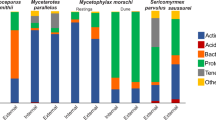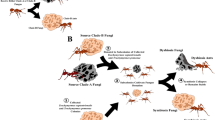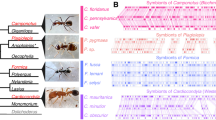Abstract
The well-studied, ancient and highly evolved mutualism between fungus-growing ants and their fungi has become a model system in the study of symbiosis1,5. Although it is thought at present to involve only two symbionts, associated with each other in near isolation from other organisms1,5, the fungal gardens of attine ants are in fact host to a specialized and virulent parasitic fungus of the genus Escovopsis (Ascomycotina)6. Because the ants and their fungi are mutually dependent, the maintenance of stable fungal monocultures in the presence of weeds or parasites is critical to the survival of both organisms. Here we describe a new, third mutualist in this symbiosis, a filamentous bacterium (actinomycete) of the genus Streptomyces that produces antibiotics specifically targeted to suppress the growth of the specialized garden-parasite Escovopsis. This third mutualist is associated with all species of fungus-growing ants studied, is carried upon regions of the ants' cuticle that are genus specific, is transmitted vertically (from parent to offspring colonies), and has the capacity to promote the growth of the fungal mutualist, indicating that the association of Streptomyces with attine ants is both highly evolved and of ancient origin.
This is a preview of subscription content, access via your institution
Access options
Subscribe to this journal
Receive 51 print issues and online access
$199.00 per year
only $3.90 per issue
Buy this article
- Purchase on Springer Link
- Instant access to full article PDF
Prices may be subject to local taxes which are calculated during checkout



Similar content being viewed by others
References
Weber, N. The fungus growing ants. Science 121, 587–604 (1966).
Wilson, E. O. The Insect Societies (Belknap, Cambridge, Massachusetts, 1971).
Chapela, I. H., Rehner, S. A., Schultz, T. R. & Mueller, U. G. Evolutionary history of the symbiosis between fungus-growing ants and their fungi. Science 266, 1691–1694 (1994).
Mueller, U. G., Rehner, S. A. & Schultz, T. R. The evolution of agriculture in ants. Science 281, 2034–2038 (1998).
North, R. D., Jackson, C. W. & Howse, P. E. Evolutionary aspects of ant-fungus interactions in leaf-cutting ants. Trends Ecol. Evol. 12, 386–389 (1997).
Currie, C. R., Mueller, U. G. & Malloch, D. The agricultural pathology of ant fungal gardens. Proc. Natl Acad. Sci. USA(submitted).
Wilson, E. O. in Fire Ants and Leaf-cutting Ants. (Westview, Builder, 1986).
Schultz, T. R. & Meier, R. Aphylogenetic analysis of the fungus-growing ants (Hymenoptera: Formicidae: Attini) based on morphological characters on the larvae. Syst. Entomol. 20, 337–370 (1995).
Hölldobler, B. & Wilson, E. O. The Ants (Belknap, Cambridge, Massachusetts, 1990).
Weber, N. A. Gardening Ants: The Attines (Am. Phil. Soc., Philadelphia, 1972).
Waksman, S. A. & Lechevalier, H. A. 1962. The Actinomycetes, Vol. III. Antibiotics of Actinomycetes (Williams & Wilkins, Baltimore, 1962).
Goodfellow, M. & Cross, T. The Biology of Actinomycetes (Academic, London, 1984).
Seifert, K. A., Samson, R. A. & Chapela, I. H. Escovopsis aspergilloides, a rediscovered hyphomycete from leaf-cutting ant nests. Mycologia 87, 407–413 (1995).
Martin, M. M. & Martin, J. S. The biochemical basis for the symbiosis between the ant, Atta colombica tonsiper, and its food fungus. J. Insect Physiol. 16, 109–119 (1970).
Hervey, A., Rogerson, C. T. & Leong, I. Studies on fungi cultivated by ants. Brittonia 29, 226–236 (1978).
Cazin, J. J, Wiemer, D. F. & Howard, J. J. Isolation, growth characteristics, and long-term storage of fungi cultivated by attine ants. Appl. Env. Microbiol. 55, 1346–1350 (1989).
Vining, L. C. Functions of secondary metabolites. Annu. Rev. Microbiol. 44, 395–427 (1990).
Griffin, D. H. Fungal Physiology (Wiley-Liss, New York, 1994).
Eisner, T. Prospecting for nature's chemicals. Iss. Sci. Tech. 6, 31–34 (1990).
Beattie, A. J. Discovering new biological resources — chance or reason. Bioscience 42, 290–292 (1992).
Caporale, L. H. Chemical ecology: a view from the pharmaceutical industry. Proc. Natl Acad. Sci. USA 92, 75–82 (1995).
Holt, J. G. et al. (eds) Bergey's Manual of Determinative Microbiology9th edn. (Williams & Wilkings, Baltimore, 1994).
Wetterer, J. K., Schultz, T. R. & Meier, R. Phylogeny of fungus-growing ants (tribe Attini) based on mtDNA sequence and morphology. Mol. Phylogenet. Evol. 9, 42–47 (1998).
Acknowledgements
This work was supported by Smithsonian and NSERC predoctoral awards (to C.R.C.) and an NSERC grant (to D.M.). C.R.C. thanks the Smithsonian Tropical Research Institute and ANAM of the Republic of Panama for assisting with the research and granting collecting permits, and U.G. Mueller for guidance, support and encouragement. We thank I. Ahmad, N. Alasti-Faridani, G. de Alba, S.Barrett, E. Bermingham, A. Caballero, J. Ceballo, S. Dalla Rosa, L. Ketch, M. Leone, G. Maggiori, S.Rand and M. Witkowska for logistical support; C. Ziegler for the photograph in Fig. 1; and K. Boomsma, J. Bot, R.Cocroft, G. Currie, J. Gloer, A. Herre, H. Herz, S. Rehner, T. Schultz, N. Straus, B. Wcislo and B. Wong for comments on this study and/or manuscript.
Author information
Authors and Affiliations
Corresponding author
Rights and permissions
About this article
Cite this article
Currie, C., Scott, J., Summerbell, R. et al. Fungus-growing ants use antibiotic-producing bacteria to control garden parasites. Nature 398, 701–704 (1999). https://doi.org/10.1038/19519
Received:
Accepted:
Issue Date:
DOI: https://doi.org/10.1038/19519
This article is cited by
-
Dynamics and diversity of symbiotic bacteria in Apolygus lucorum at different developmental stages
Journal of Cotton Research (2023)
-
Bacterial diversity in arboreal ant nesting spaces is linked to colony developmental stage
Communications Biology (2023)
-
Symbioses shape feeding niches and diversification across insects
Nature Ecology & Evolution (2023)
-
Effectiveness of an ethanol extract of jet black ant nests for combatting nosemosis in apiary honey bees
Apidologie (2023)
-
Ants/Nest-Associated Fungi and Their Specialized Metabolites: Taxonomy, Chemistry, and Bioactivity
Revista Brasileira de Farmacognosia (2023)
Comments
By submitting a comment you agree to abide by our Terms and Community Guidelines. If you find something abusive or that does not comply with our terms or guidelines please flag it as inappropriate.



